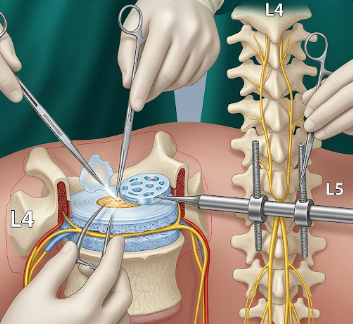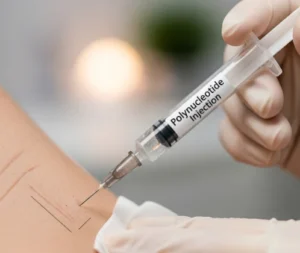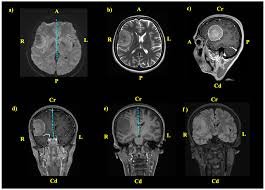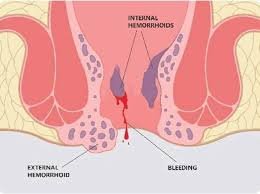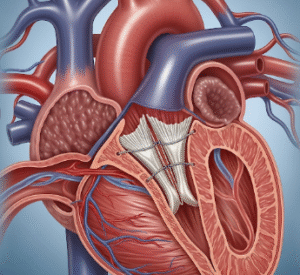Overview
Transforaminal Lumbar Interbody Fusion (TLIF) is a spinal surgery performed to treat degenerative disc disease, spinal instability, or spondylolisthesis in the lumbar (lower back) region. TLIF stabilizes the spine by removing the damaged disc and fusing two adjacent vertebrae using a bone graft and sometimes metal implants.
In Korea, TLIF is offered at advanced orthopedic and neurosurgery centers, using minimally invasive techniques and high-precision instrumentation, ensuring optimal outcomes, reduced blood loss, and faster recovery.
What is TLIF?
TLIF is a posterior approach spinal fusion that provides stability and pain relief for patients with chronic lower back issues.
Indications for TLIF include:
- ✦ Degenerative disc disease causing chronic back pain
- ➤ Spinal instability due to spondylolisthesis
- ✦ Recurrent disc herniation or failed previous spinal surgery
- ➤ Compression of nerve roots leading to pain, numbness, or weakness in the legs
Benefits include:
- Pain relief in the lower back and legs
- Restoration of spinal stability
- Prevention of further degeneration
- Long-term improvement in mobility and function
What are the Benefits?
✅ Stabilizes the affected spinal segment
➤ Relieves nerve compression and associated leg pain
✅ Can be performed using minimally invasive techniques
➤ Reduces blood loss, scarring, and hospital stay
✅ High success rates in Korean spinal surgery centers
➤ Improves quality of life and allows return to daily activities
Procedure Details
1) How should I prepare for TLIF?
- ✦ Comprehensive preoperative evaluation: X-rays, MRI, and CT scans
- ➤ Blood tests, ECG, and anesthesia assessment
- ✦ Review medications, especially blood thinners, with your surgeon
- ➤ Arrange help at home for initial recovery and mobility
2) What happens during the procedure?
- ✦ Performed under general anesthesia
- ➤ Patient positioned face-down for posterior spinal access
- ✦ Damaged disc is removed via a transforaminal approach
- ➤ Bone graft (autograft, allograft, or synthetic) is placed in the disc space
- ✦ Pedicle screws and rods may be used for additional stabilization
- ➤ Procedure duration: 2–4 hours, depending on complexity
- ✦ Minimally invasive TLIF uses smaller incisions and tubular retractors
3) What happens after TLIF?
- ✦ Hospital stay: typically 3–5 days for monitoring
- ➤ Pain management, physical therapy, and early mobilization are initiated
- ✦ Restrictions on bending, lifting, or twisting for 6–12 weeks
- ➤ Follow-up X-rays or CT scans ensure proper fusion
- ✦ Full recovery may take 3–6 months, with gradual return to normal activity
Risks / Benefits
Possible Risks:
- Infection or bleeding
- Nerve injury or persistent pain
- Pseudarthrosis (failure of fusion)
- Hardware failure or loosening
- Rare complications: paralysis or severe neurological deficits
Benefits:
- Effective pain relief and spinal stabilization
- Minimally invasive techniques reduce complications
- Improves mobility, function, and quality of life
- In Korea, advanced surgical techniques and experienced surgeons optimize outcomes
Recovery and Outlook
- ✦ Early mobilization encouraged within days of surgery
- ➤ Physical therapy continues for several weeks
- ✦ Most patients resume light activities within 4–6 weeks
- ➤ Full fusion and optimal spinal strength typically achieved in 3–6 months
- ✦ Korean hospitals provide structured rehabilitation programs to maximize recovery
When To Call the Doctor
⚠ Severe or worsening back or leg pain
⚠ Signs of infection: fever, redness, or discharge
⚠ Numbness, weakness, or loss of bladder/bowel control
⚠ Hardware-related complications such as instability or unusual pain
Best Korea Option / Process
Korea offers world-class spinal surgery care:
- ✦ Experienced orthopedic and neurosurgeons specializing in minimally invasive TLIF
- ➤ State-of-the-art operating rooms and imaging guidance
- ✦ Postoperative care including pain management and rehabilitation
- ➤ Shorter hospital stays and faster recovery
- ✦ Comprehensive packages including surgery, anesthesia, implants, and follow-up
- ➤ English-speaking international patient coordinators
Highlights of TLIF in Korea
- ✅ Minimally invasive approach for lumbar spine fusion
- ➤ Reduces blood loss, scarring, and hospital stay
- ✅ Stabilizes the spine and relieves nerve compression
- ➤ Advanced instrumentation and surgical expertise
- ✅ High success rates with comprehensive postoperative care

